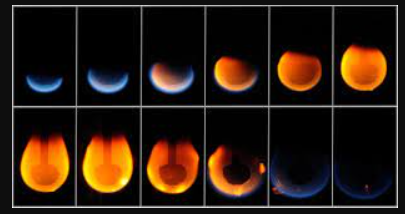In a vast and enigmatic universe, the absence of gravitation causes extraordinary and singular phenomena.
A captivating topic that has captivated the imagination of scientists and space enthusiasts is the behavior of fire in weightlessness. In this article, we examine how fire behaves in a zero-gravity environment, revealing the science’s floating dance that defies our expectations.
Fire is essentially a chemical reaction between a fuel and an oxidizer, which typically takes place on Earth in the presence of oxygen. However, in space, where gravity is nearly nonexistent, flames appear and behave differently.

When a flame is ignited in weightlessness, it does not rise as it would on Earth, but forms a conical shape instead. Instead, the flames take on the shape of a nearly flawless spheroid. Without gravity to draw the heated gases upward, the flame does not have a preferred direction of propagation.
Burning in Zero Gravity
Additionally, the absence of gravity has a significant impact on the combustion process. The oxygen required for combustion on Earth is supplied by the ambient air. However, space contains no oxygen.
In order for a fire to self-sustain, an independent oxygen supply is required. In experiments conducted on the International Space Station, special devices are used to supply flames with controlled oxygen.
In addition to its shape and delivery of oxygen, weightless fire possesses additional characteristics. As particles of fuel, liquids, or substances, they do not descend to the ground in space, allowing them to float freely in the environment.
This can result in peculiar behavior, such as the formation of fuel particles in the air. These bubbles may ignite slowly or divide into numerous smaller flames, resulting in a distinctive display.
In addition to its scientific and aesthetic appeal, the study of weightless fire has significant practical implications. Understanding the behavior of fires in space will enhance the safety of piloted space missions and aid in the development of more effective fire suppression systems.
Additionally, the study of combustion in microgravity may have applications on Earth. By eliminating the effect of gravity, scientists can obtain a deeper understanding of combustion processes and use this knowledge to enhance the efficiency of engines and combustion systems on Earth.

